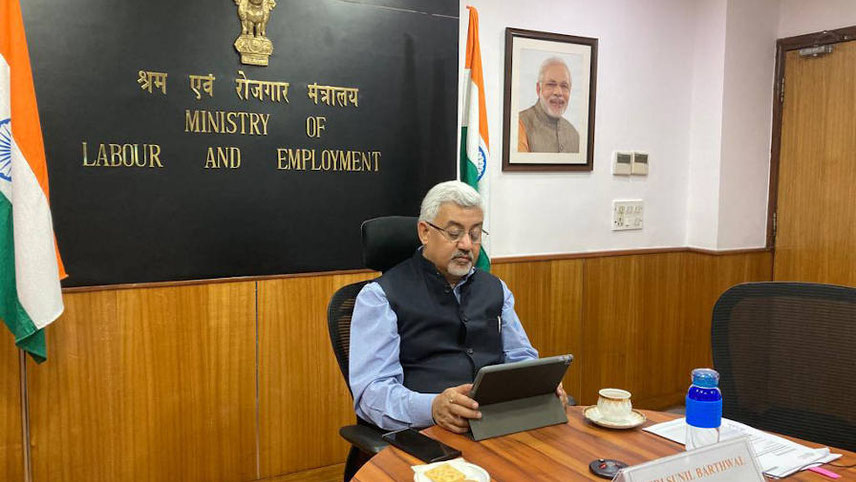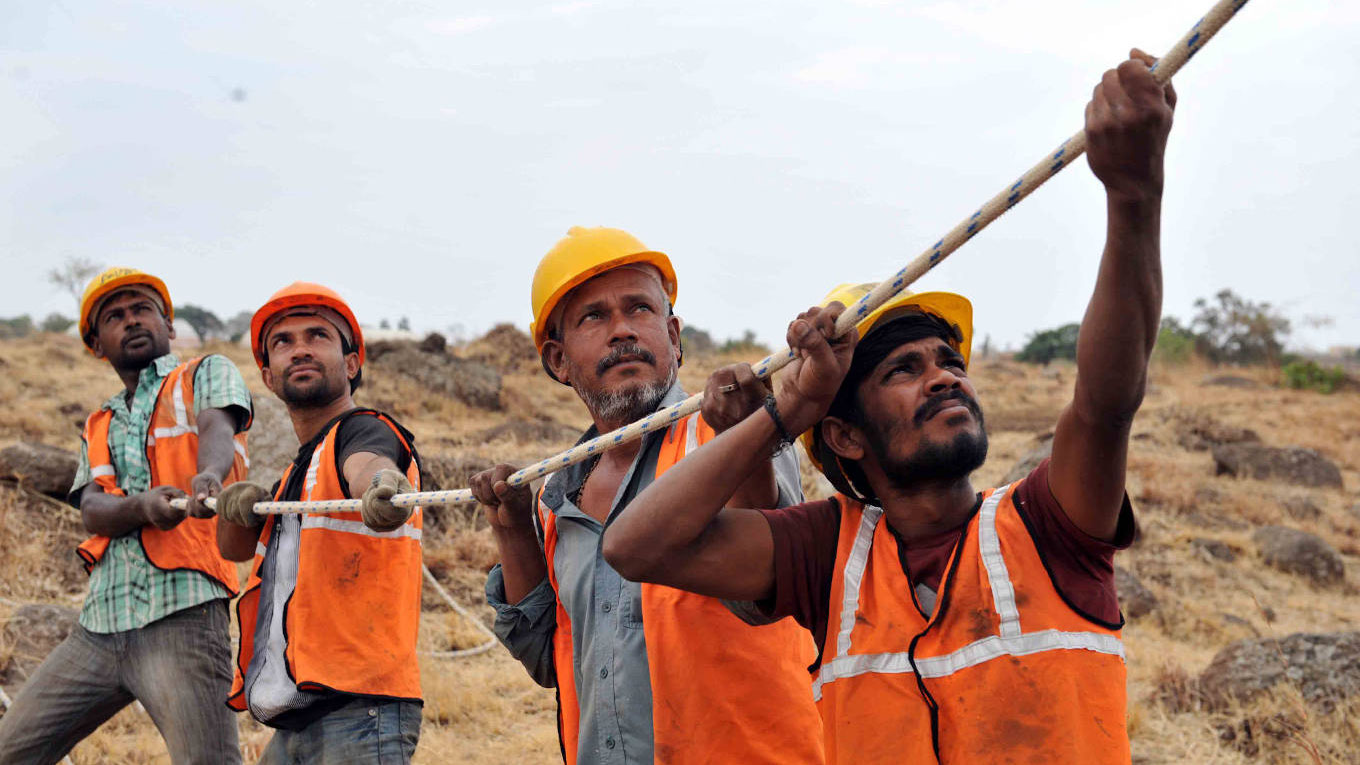-

Barthwal: changes are important
Other stakeholders were also roped in to back the government move. Giving a meaningful context to the labour codes, T.V. Narendran, president, CII, recently pointed out that the Covid outbreak has severely impacted the global economy. Judging by the current economic climate, the slowdown is likely to continue for some time, keeping investments stagnant. “At this point, it is important to incentivise the industrial ecosystem in order to boost business sentiments and restart economic operations. Labour reforms in India have been widely discussed for many years and the damage caused by the pandemic calls for such structural reforms.”
PM advisors’ reservations
But then reservations cropped up from within – this time over the manner in which the labour codes had been conceived and drafted. In its report on state-level labour reforms in India, the Economic Advisory Council to the PM (EAC-PM) backed a unified labour code, instead of four separate ones, much on the lines of the Bangladesh Labour Act of 2006, saying that the labour reforms undertaken in form of four Codes did not take a comprehensive view of all labour laws and had only standardised and streamlined the existing statutes without addressing definitional inconsistencies.
The EAC-PM called for further simplifying of the labour laws and called for other alternative policy efforts to boost employment generation and industrial growth like skill building, public infra investment, reducing policy barriers to trade and investment and simplifying laws and procedures.
The report, prepared at the request of the PMO to examine the impact of state-level labour law reforms on employment and economic growth, has called for a need to focus on urban areas, given their significance from a national income as well as overall employment standpoint. It is of the view that labour law reforms, though important, are not a magic bullet to boost employment generation, address the high degree of informality or even boost industrial growth, and has questioned a need for spending political capital on “some” labour law reforms, which are not enough for employment generation. There should be an enhanced focus on skill building, public infra investment, reducing policy barriers to trade and investment and simplifying laws and procedures.
The EAC-PM is headed by Bibek Debroy, a pro-Modi economist, who has been of the view that labour laws should actually be employment laws, the kind of thing that Bangladesh did in 2006, which cuts across everything. Its other members are Rakesh Mohan, Sajjid Chinoy, Neelkanth Mishra, Nilesh Shah, T.T. Ram Mohan and Poonam Gupta.
What exactly has the Bangladesh Labour Act of 2006 done to merit consideration in India? Bangladesh’s economic transformation is driven in large part by social changes, starting with empowerment of women. The Bangladesh Labour Act nurtures this empowerment. The transformation is also linked to the success of its garments industry and one notable aspect is the garments firms in Bangladesh are large compared in India owing to different labour laws. The absence of a law that explicitly curtails labour-market flexibility, like our 1947 Industrial Disputes Act did, has been a boon for job creation and manufacturing success.
The prescriptions of EAC-PM are believed to have led to a rethink within certain circles in the government, putting it in a fix of sorts. Pushing the labour codes is essential to reinforce the government’s credibility. Soon after the parliamentary approval, the Union labour ministry set a target to implement the Codes by January 2021. Since then, it has missed at least three more deadlines – April 2021, July-August 2021 and October 2021. Now there is a strong belief that it may not happen till the next financial year due to several reasons including the upcoming assembly elections, and the continued stress in the economy, at least in several sectors if not all. Yet, as the EAC-PM points out, should the government spend political capital on “some” labour reforms?
-

Debroy: labour laws should actually be employment laws
States holding back
The real catch, however, is that since labour is a concurrent subject, both the Centre and states have to frame the rules. Although the Centre notified the codes in September 2020, no state has notified the requisite rules under these codes. The states that have published the draft rules so far are mostly the BJP-ruled states. But even these states have yet to implement the codes.
This is surprising as the BJP has successfully pushed its states like Uttar Pradesh, Gujarat, Goa and Madhya Pradesh earlier to undertake a separate set of labour reforms to attract investments. Industries operating in these states have flexibility in hiring and there is a significant reduction in compliance regulations. Administrative processes for returns, inspections, approvals and clearances have been accelerated. By implementing the codes in its states, the BJP could have set an example for others to follow.
“From labour reform perspective, 2021 is a year of stalemate. Governments both at the states and at the Centre seem to have got convinced that there is an economic as well as political cost of implementing the labour codes. After the hurried passage of the bills in 2020, I can clearly believe that the Centre is a party to this delay in implementation,” says K.R. Shyam Sundar, a labour economist and professor at XLRI, Jamshedpur.
Sunil Barthwal, Union labour secretary, says the government is pursuing with the states because this law is in the concurrent list of the Constitution and rules have to be formed both at the Central and state levels. “We, at the Central government level, have pre-published the rules and are ready and as soon as the majority of the state governments frame their rules then we will be ready to implement the Code,” he added.
The labour secretary also said more and more states are coming up in terms of notification and finalisation of rules. “We have to be fast as everybody is eagerly waiting for these rules to see the light of the day,” he said.
Two guiding principles
Speaking on the new codes, Barthwal stated that the two guiding principles on which the rules have been designed include ease of living for the workers and ease of doing business for employers. A big inclusion, he highlighted, in the labour code was the inclusion of the gig and platform workers. “India is among the three largest platform economies,” he added.
Barthwal further stated that these changes are important, and the government wanted the whole labour code to be inclusive. Highlighting the importance of social security funding, which was available to organised workers, Barthwal said the government is now extending it to unorganised workers as well.
But it is only once all the states are on-board that the codes will be implemented. The progress is indeed slow. In all, 24 states/UTs have, till 16 December, published draft rules under code on wages, 20 states on code on industrial relations, 18 on code on social security and 13 on the code occupational safety, health and working conditions.
This is perplexing because it was at the very beginning of the Modi government’s tenure that it embarked on the reform path to amalgamate 29 labour laws into four distinct Codes. The Centre also announced that it wants to implement all the four codes at one go across the country and hence, any delay on the part of the states to prepare and finalise the rules would mean a prolonged wait for the businesses and industry to enjoy the ease of doing business that the codes are expected to bring in.
-
From labour reform perspective, 2021 is a year of stalemate. Governments both at the states and at the Centre seem to have got convinced that there is an economic as well as political cost of implementing the labour codes. After the hurried passage of the bills in 2020, I can clearly believe that the Centre is a party to this delay in implementation
India Inc welcomes codes
India Inc. welcomed the announcements. Among the significant moves was the proposed increase in the threshold from 100 workers to 300 workers (in a unit) for seeking prior permission for retrenchment, lay-off and closure, is prescribed in the Industrial Relations Code. The Centre, in a simultaneous bid to mollify the trade unions, maintaining that there has been no empirical evidence to suggest that higher threshold promotes hire and fire.
The IR Code also proposes to tighten trade unionism in the industry. Under a new feature on “recognition of negotiating union”, it has been proposed that a trade union will be recognised as sole “negotiating union” if it has support of 51 per cent or more of the workers on the muster roll in an establishment.
If no such trade union has support of 51 per cent or more of workers on the muster roll of that industrial establishment, then a negotiating council will be constituted for negotiation. The provision for workers resorting to strike has also been tightened.
The labour codes also envisage better social security cover for the over 50 crore workers from organised, unorganised and self-employed. The social security net of ESIC and EPFO will be widened to bring in all workers and self-employed persons under it.
But TUs are sore
Yet the TUs are not happy. Take the case of construction labour. According to Sasi Kumar, general secretary of Construction Workers Federation of India, the 13 labour laws that were merged into the Code on Occupational Safety, Health and Working Conditions, included the Building and Other Construction Workers (Regulation of Employment and Conditions of Service) Act and Inter-State Migrant Workmen Act.
Labour unions and activists have recently written to the Central government, saying that the new labour codes will lead to lower social security benefits for the informal sector, especially construction workers. The National Campaign Committee For Central Legislation on Construction Labour flagged the increase in construction value limit to collect cess earlier this month, stating it will hurt worker welfare.
“Earlier cess was collected from constructions valued above Rs10 lakh. Now, this limit has been raised to Rs50 lakh; hence the cess will be reduced considerably,” it said in a letter to the Ministry of Labour & Employment. “Registration of beneficiaries may also be adversely affected in case of construction workers working on smaller sites.”
The Building and Other Construction Workers (Regulation of Employment and Conditions of Service) Act, 1996, and the Building and Other Construction Workers’ Welfare Cess Act, 1996, mandates 1 per cent cess collection on the cost of construction. This money is to be used for the welfare of workers in the informal construction sector. Total corpus collected under BOCW Act stood at Rs52,000 crore as of the year ended March 2021. Of this, states were asked to use Rs31,000 crore for Covid-19 relief measures. Sasi Kumar says some laws on workers in the construction sector were merged with the Code on Social Security. “If (the new) labour codes are implemented, BOCW Act and Cess Act will cease to operate.”
-

Narendran: a huge step forward
Government’s view
Till the EAC-PM struck a somewhat discordant note, the government firmly believed that these reforms will pave way for the welfare of workers in both organised and unorganised sectors. It also claimed that the four labour codes will also introduce sweeping changes that would affect both businesses and workers.
Indeed, officials engaged in the drafting of the codes were at pains to highlight the checks and balances they had brought in. While employers would have greater flexibility in rolling out short-term work contracts and while industrial strikes may become harder, a new national wage
floor could benefit workers, besides informal and gig workers will have a new social security net. A key change in the definition of “wage” would impact take-home pay, but increase the retirement savings – something that a section of employers are opposed to as it may increase their employee costs.
Trade union leaders were holding back but it wasn’t that they were intransigent, like the farmers were all throughout. Their complaint was that while the wage code talks about mandatory national minimum wage, it is yet to be worked out even two years after the code was passed. The mandatory national minimum wage had hit a roadblock not because of any significant political resistance.
It was the labour ministry which was dragging its feet, setting up a third committee to work out the floor wage, after rejecting the first committee report and disbanding second following the resignation of a few members. “We support all pro-worker measures…But we have been maintaining that the four codes need to be reworked after due diligence and wide consultations afresh,” said Amarjeet Kaur, general secretary, All India Trade Union Congress.
On the other side, industry leaders like CII’s Narendran were saying that the labour reforms introduced are comprehensive and progressive, marking a huge step forward in the labour environment for the country. These reforms will definitely enhance the employment landscape, in addition to giving a fillip to investments and sustainable growth, he felt.
In between, however, the PM’s economic advisors have begun singing a different tune. The government has some way to go in addressing the workers’ concerns. A lot will depend on the outcome of the assembly elections in five states. It also remains to be seen if the states come on board subsequently.
-
Earlier cess was collected from constructions valued above Rs10 lakh. Now, this limit has been raised to Rs50 lakh; hence the cess will be reduced considerably
The four Codes
An examination of the four Labour Codes reveals the changes that are under contemplation – and why the changes may not get the kind of reception as being envisaged.
The Code on Wages, notified in August 2019, subsumes the provisions of four laws – Payment of Wages Act, the Minimum Wages Act, the Payment of Bonus Act, 1965 and the Equal Remuneration Act. It applies to all establishments and to all employees in both organised and unorganised sectors. The code prohibits discrimination between wages payable to a male and a female for the same work done.
This code also envisages uniform applicability of the provisions of timely payment of wages and minimum wages to all employees. It introduces the concept of a floor wage, which is to be determined by the Centre after taking into account the minimum living standards of workers which may be different for different geographical areas. The state government can, under no circumstance, fix a minimum wage rate which is lower than the floor rate determined by the Centre.
States have always had freedom to increase the upper end of wage rates which happens mostly under political pressure. Recently, for instance, the government of election-bound Punjab hiked the minimum rate of wages from Rs8,766 to Rs9,9192 per month. But in a setback to the businessmen, the hike will be applicable from March 2020. At a time when there is a severe slump in the market and MSMEs are struggling for survival, the backdated increase has come as a big blow to small businessmen.
The Code on Social Security (SS) subsumes nine laws and empowers the Centre to notify various social security schemes and laws like the Employees’ Provident Funds and Miscellaneous Provisions Act, 1952; the Employees’ State Insurance Act, 1948; the Employees’ Compensation Act, 1923; the Employment Exchanges (Compulsory Notification of Vacancies) Act, 1959; the Maternity Benefit Act, 1961; the Payment of Gratuity Act, 1972; the Cine-workers Welfare Fund Act, 1981; the Building and Other Construction Workers’ Welfare
Cess Act, 1996 and the Unorganised Workers Social Security Act, 2008. It also empowers the Centre to frame any other schemes for the self-employed, unorganised workers, gig workers and platform workers and the members of their families.
Firms employing more than 20 workers have to mandatorily report vacancies online under this code. The Code has provision for the creation of a social security fund for workers in the unorganised sector. Employees may be able to enjoy a four-day workweek provided the total working hours in the entire week is not less than 48 hours. But critics say that the four-day week is a western concept meant to address work-life balance and thereby boost employee morale. Nearer home, the UAE has implemented a four-and-a-half-day working week for all government employees. A four-day week will mean 12 hours of daily work. Some fear it could be the recipe for a burnout in India.
-
A four-day week will mean 12 hours of daily work. Some fear it could be the recipe for a burnout in India
The Code of Wages and the Code on Social Security (SS) contain a unified definition of ‘wage’ which was earlier interpreted differently under different labour laws.
A key change in the definition of “wage” would impact take-home pay, but increase retirement savings – something that a section of employers are opposed to as it may increase their employee costs.
Till now, employers have been splitting wages into numerous allowances to keep basic wages low to reduce provident fund and income tax outgo. The new wages code provides for provident fund contribution as a prescribed proportion of 50 per cent of gross pay.
The Code on Industrial Relations amalgamates three existing laws and expands the definition of worker to include persons employed in a skilled or unskilled, manual, technical, operational and clerical capacity. Besides, persons employed in a supervisory capacity and earning less than Rs18,000 per month have been brought under the definition.
The code introduces a new provision for fixed term employment, giving employers flexibility to engage a worker on the basis of a written contract. Fixed term employees will get the same benefits as the permanent employees.
Besides, the new industrial relation code would also improve ease of doing business by allowing firms with up to 300 workers to go ahead for lay-offs, retrenchment and closure without government permission. At present all firms with up to 100 employees are exempted from government permission for lay-off, retrenchment and closure.
And finally, The Occupational Safety, Health And Working Conditions (OSH) Code amalgamates 13 existing labour laws and applies to factories having at least 20 workers if the manufacturing process is being carried on with the aid of power and 40 if the manufacturing process is being done without power.
Under this code, employers are required to ensure that the workplace is free from hazards which cause injury or occupational disease to the employees, provide free annual health examination or test, free of costs to certain classes of employees.
A provision has been made for employers to provide travelling allowance annually to an inter-state migrant worker for undertaking a to-and-fro journey to his native place. Further, providing appointment letters to the workers has been made mandatory.





































